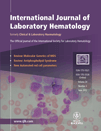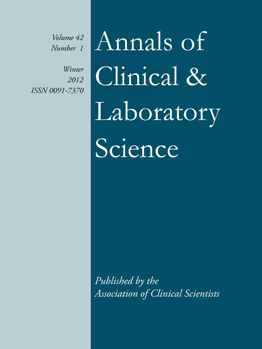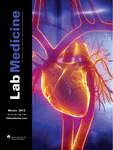
ANNALS OF CLINICAL BIOCHEMISTRY
Scope & Guideline
Connecting Researchers with Healthcare Professionals.
Introduction
Aims and Scopes
- Clinical Laboratory Diagnostics:
The journal extensively covers the development and validation of diagnostic assays and methodologies, emphasizing the importance of accurate laboratory testing in clinical settings. - Biochemical Markers and Disease Associations:
Research on various biochemical markers, their roles in disease diagnosis and management, and their implications in different patient populations is a core focus. - Quality Assurance and Improvement:
Publications often address quality control, analytical performance, and the standardization of laboratory practices to enhance diagnostic accuracy and patient safety. - Emerging Technologies in Biochemistry:
The journal explores the integration of new technologies, such as machine learning and point-of-care testing, into clinical biochemistry, highlighting innovations that improve diagnostic capabilities. - Public Health and Epidemiology:
Studies examining the biochemical aspects of public health, including the impact of environmental factors and disease prevalence in populations, are frequently featured. - Ethics and Laboratory Management:
The journal addresses ethical considerations and management practices in clinical laboratories, particularly in the context of evolving patient demographics and treatment protocols.
Trending and Emerging
- Integration of Artificial Intelligence:
Research exploring the use of artificial intelligence and machine learning in clinical biochemistry for improving diagnostics and laboratory efficiency is on the rise, showcasing the potential for enhanced data analysis and decision support. - Point-of-Care Testing Innovations:
The development and validation of point-of-care testing devices are increasingly prominent, reflecting the demand for rapid and accessible diagnostic tools in various healthcare settings. - Biomarker Discovery for Chronic Diseases:
There is a growing emphasis on discovering and validating biomarkers for chronic diseases such as diabetes, cardiovascular diseases, and cancer, which is critical for early detection and personalized treatment. - Impact of Environmental Factors on Health:
Research examining the biochemical impacts of environmental factors, such as climate change and pollution, on health outcomes is gaining traction, indicating a broader perspective on public health. - Patient-Centric Laboratory Practices:
The focus on patient experience and the implementation of strategies to enhance patient-centered laboratory practices is emerging as a significant theme, aiming to improve the overall quality of care. - Quality Improvement Initiatives:
Publications related to quality improvement initiatives in laboratory settings are increasingly common, emphasizing the need for continuous enhancement of laboratory processes and patient safety.
Declining or Waning
- Traditional Biochemical Assays:
The reliance on traditional biochemical assays has decreased as more advanced technologies, such as high-throughput screening and molecular diagnostics, gain prominence. - Static Reference Intervals:
The publication of studies that establish static reference intervals for biochemical markers has become less common, as there is a growing emphasis on personalized medicine and dynamic reference values. - Basic Research on Biochemical Pathways:
There has been a noticeable decline in basic research articles focused solely on biochemical pathways without direct clinical application or relevance to laboratory diagnostics. - General Case Reports:
The journal has shifted towards more complex and novel case reports that contribute significantly to clinical practice, resulting in fewer publications of general case reports that do not offer new insights. - Single-Center Studies:
There is a trend away from single-center studies, with a preference for multicenter collaborations that provide broader and more generalizable data.
Similar Journals

Practical Laboratory Medicine
Pioneering Discoveries in Clinical Biochemistry and TechnologyPractical Laboratory Medicine is a distinguished peer-reviewed journal published by Elsevier, focusing on the essential advances in the fields of clinical biochemistry and radiological technology. Begun in 2015, this Open Access journal fosters an environment of scholarly communication, ensuring that valuable research is freely available to a global audience. With a current impact factor placing it in the Q3 quartile in both clinical biochemistry and radiological and ultrasound technology, the journal serves as a vital platform for researchers and professionals to disseminate innovative findings and foster interdisciplinary collaboration. The journal’s commitment to covering a broad spectrum of laboratory medicine topics, from clinical practice improvements to technological developments, underlines its importance in enhancing laboratory standards and patient care. Based in Amsterdam, Netherlands, Practical Laboratory Medicine not only contributes to the academic community but also influences practical applications in healthcare settings.

International Journal of Laboratory Hematology
Exploring breakthroughs in laboratory practices for better health.The International Journal of Laboratory Hematology, published by WILEY, serves as a vital resource in the field of hematology, delivering high-quality research findings and innovations within laboratory practices since its inception in 2007. This journal, accessible under Open Access options, showcases cutting-edge studies that span critical aspects of biochemistry and clinical laboratory methodologies. With a notable impact factor reflected in its Q2 and Q3 rankings across various categories—such as Biochemistry (medical) and Hematology—this journal stands out within the Scopus rankings, positioning itself within the 60th and 59th percentiles of its respective fields. Situated in the United Kingdom, the journal's objectives lie in disseminating pivotal research that enhances our understanding of hematological disorders and laboratory techniques, making it an essential tool for researchers, professionals, and students alike who are committed to advancing the science of laboratory hematology and its applications.

Annals of Laboratory Medicine
Exploring Breakthroughs in Clinical BiochemistryAnnals of Laboratory Medicine, published by the KOREAN SOC LABORATORY MEDICINE, stands as a pivotal resource for researchers and practitioners in the fields of clinical and medical biochemistry. With a strong Q2 ranking in both Biochemistry (medical) and Clinical Biochemistry, along with a prestigious Q1 status in miscellaneous Medicine categories, this journal emphasizes the significance of laboratory medicine in improving patient outcomes and advancing scientific understanding. Established in 2012, the journal has demonstrated an impressive trajectory of growth and scholarly contribution, making it a reliable source of high-quality research and insightful reviews. The journal utilizes open access, enhancing the reach of its findings across the global scientific community. Operating from South Korea, Annals of Laboratory Medicine aims to foster dialogue and collaboration among professionals, contributing to the continuous advancement of laboratory methodologies and diagnostics.

Biochemia Medica
Advancing the Frontiers of Medical BiochemistryBiochemia Medica is a premier open-access journal that has been at the forefront of advancing knowledge in the fields of medical biochemistry and laboratory medicine since its inception in 2006. Published by the Croatian Society of Medical Biochemistry & Laboratory Medicine, this journal serves a vital role in disseminating high-quality research findings and reviews that contribute to the understanding of biochemical processes in health and disease. With an impressive performance in the Scopus ranking, it holds a Q2 quartile category in both medical biochemistry and clinical biochemistry for 2023, reflecting its commitment to scholarly excellence and relevance in the field. As an open-access journal, Biochemia Medica ensures that research is freely accessible, fostering collaboration and innovation among researchers, healthcare professionals, and students globally. Positioned within a rapidly evolving scientific landscape, this journal is dedicated to bridging the gap between laboratory research and clinical application, making it an indispensable resource for anyone interested in the intersections of biochemistry and medicine.

ANNALS OF CLINICAL AND LABORATORY SCIENCE
Exploring the Frontiers of Laboratory ScienceANNALS OF CLINICAL AND LABORATORY SCIENCE, published by the Association of Clinical Scientists, is a pivotal journal in the fields of clinical biochemistry, hematology, immunology, and medical laboratory technology. Since its inception in 1971, this journal has become a vital resource for researchers and practitioners aiming to advance their knowledge and skills in laboratory sciences. Although currently not an open access journal, its rich repository of peer-reviewed articles and studies contributes significantly to the academic discourse in diagnostic and therapeutic practices. The journal is categorized in various quartiles, reflecting its impact and contributions to multiple scientific domains, such as Q4 in Clinical Biochemistry and Q3 in Pathology and Forensic Medicine as of 2023. With an extensive convergence of years up to 2024, it proves to be a timeless source for emerging trends and research innovations. The ANNALS OF CLINICAL AND LABORATORY SCIENCE not only supports the professional development of its readers but also encourages interdisciplinary collaboration, making it an essential tool for professionals, students, and researchers dedicated to improving health outcomes through advanced laboratory sciences.

Malaysian Journal of Pathology
Empowering the future of pathology with rigorous scholarship.Malaysian Journal of Pathology, published by the MALAYSIAN JOURNAL PATHOLOGY, stands as a pivotal resource in the fields of pathology and medicine, contributing rich insights since its inception in 1979. This peer-reviewed journal, based in Malaysia, is dedicated to disseminating original research, review articles, and case studies that advance the understanding of disease mechanisms and diagnostics. With a current impact factor reflecting its ranked positioning—Q4 in Cell Biology, Q4 in Histology, and Q3 in both Miscellaneous Medicine and Pathology & Forensic Medicine—this journal serves as an essential platform for researchers, clinicians, and students alike. Although it operates without open access, its scholarly rigor and contributions are well recognized, holding ranks such as #84 in Pathology and Forensic Medicine according to Scopus. The Malaysian Journal of Pathology is committed to fostering innovation and excellence in medical research, making it an invaluable tool for professionals seeking to stay abreast of significant advancements in the pathology domain.

AMERICAN JOURNAL OF CLINICAL PATHOLOGY
Advancing the Frontiers of Clinical PathologyThe American Journal of Clinical Pathology, published by Oxford University Press Inc, stands as a vital resource in the fields of pathology and clinical medicine. With a rich history dating back to 1945 and an impressive impact factor reflected in its Q1 ranking in Pathology and Forensic Medicine, this journal serves as a cornerstone for researchers and professionals seeking to advance their knowledge and practice. Covering a breadth of topics within the discipline, it is recognized in 2023 as ranked #24 out of 208 in its category, highlighting its esteemed reputation within the scientific community. Although the journal does not currently offer open access, its rigorous peer-reviewed articles and cutting-edge research make it an essential addition to any academic or clinical library. The ISSN for print version is 0002-9173, with an E-ISSN of 1943-7722 available for digital access. Researchers, students, and practitioners alike will benefit from its comprehensive scope and commitment to disseminating high-quality scientific inquiry.

Revista Romana de Medicina de Laborator
Connecting Researchers to Transform Medical ScienceRevista Romana de Medicina de Laborator is a prominent open-access journal published by SCIENDO, dedicated to the field of medical laboratory technology and biochemistry. Since its inception, this journal has been a vital platform for disseminating research findings and advancements in laboratory medicine. With an ISSN of 1841-6624 and E-ISSN 2284-5623, it has served the academic community since 2008 and has embraced an open-access model since 2013, ensuring that valuable research is accessible to all. While it features niche rankings in Scopus for areas such as Medical Laboratory Technology and Clinical Biochemistry, it consistently strives to engage researchers, professionals, and students. Its rich collection of articles highlights innovative techniques and methodologies, supporting the ongoing development of laboratory practices. Although its coverage in Scopus has been discontinued, the journal continues to publish high-quality studies that contribute significantly to the field, fostering knowledge exchange essential for advancing medical science.

Pathology and Laboratory Medicine International
Elevating standards in pathology and laboratory practices.Pathology and Laboratory Medicine International is a premier open-access journal, published by DOVE MEDICAL PRESS LTD, dedicated to advancing the field of pathology and laboratory medicine. Since its inception in 2009, this journal has provided a vital platform for researchers, clinicians, and educators to disseminate findings, challenges, and innovations that shape laboratory practices and pathology diagnostics. With an emphasis on peer-reviewed, high-quality research, Pathology and Laboratory Medicine International aims to enhance knowledge and improve clinical outcomes by sharing best practices and emerging trends in the discipline. As an open-access publication, it ensures global accessibility to critical research findings, fostering an inclusive academic environment. The journal holds a commendable reputation within the scientific community, making it a valuable resource for students, professionals, and researchers committed to excellence in the field.

LABORATORY MEDICINE
Pioneering insights in clinical and laboratory biochemistry.LABORATORY MEDICINE, published by Oxford University Press, is a pivotal journal in the fields of biochemistry and clinical biochemistry, officially indexed under ISSN 0007-5027 and E-ISSN 1943-7730. Since its inception in 1973, it has provided a vital platform for the dissemination of high-quality research, facilitating scholarly communication and innovation in laboratory diagnostics and biochemistry practices. The journal is classified in the Q3 quartile for medical biochemistry and Q4 for clinical biochemistry, reflecting its commitment to enhancing the scientific community's understanding of laboratory science. With its quarterly publications and rigorous peer-review process, LABORATORY MEDICINE serves as an essential resource for researchers, professionals, and students alike, offering insights into the latest developments and methodologies in the field. As a part of a rapidly evolving discipline, the journal is not only dedicated to publishing original research but also aims to present reviews, case studies, and expert opinions that contribute to the advancement of laboratory medicine. In a global context, it emerges as a significant player, prioritizing accessibility, though currently maintaining a subscription-based model, facilitating informed research and clinical application.